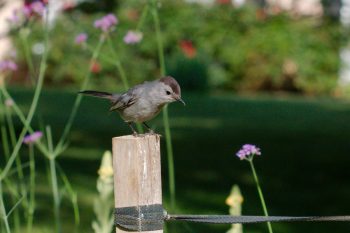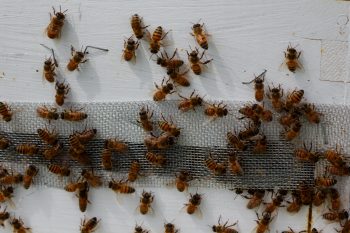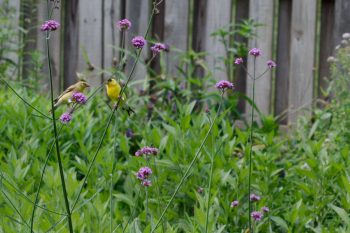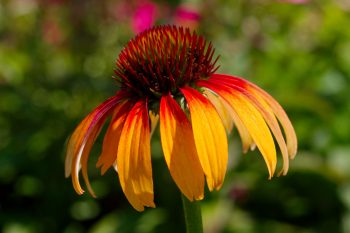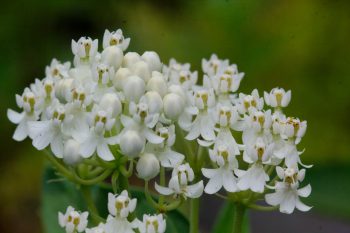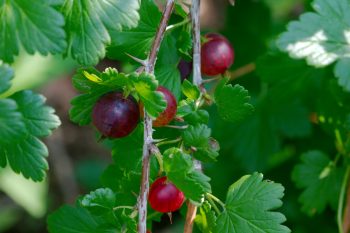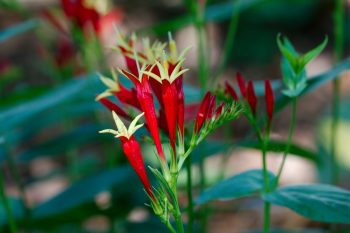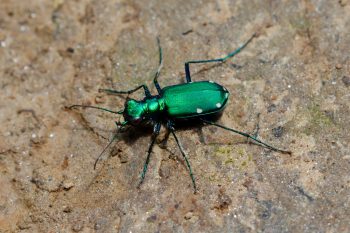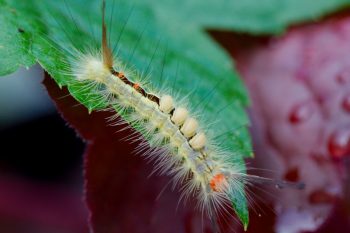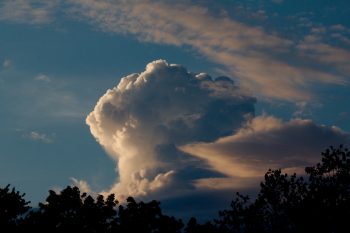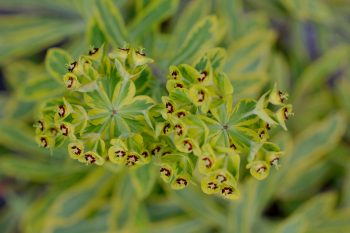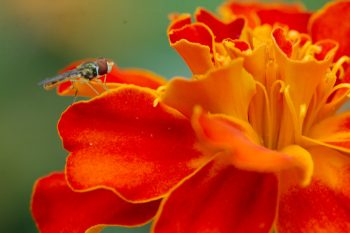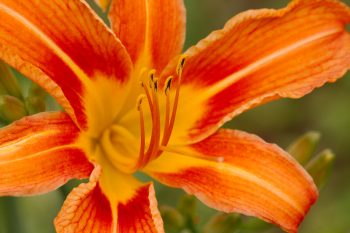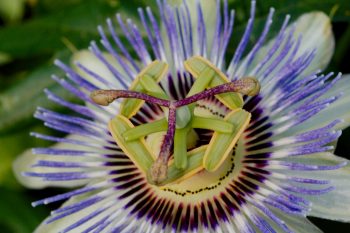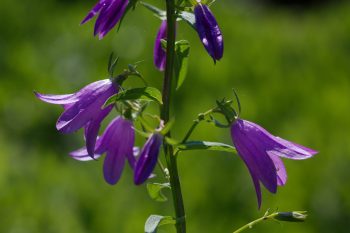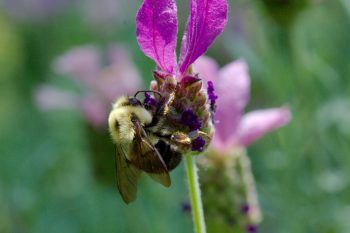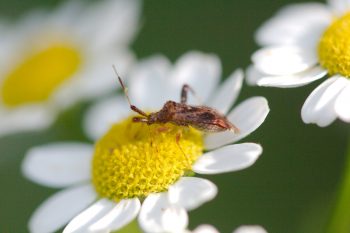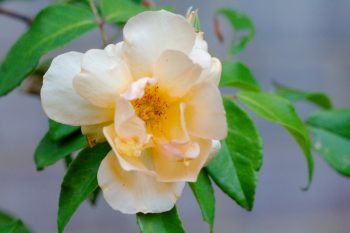After work, except on days when it’s raining, I’ve been trying to sit in the yard to read. It’s started to get warm lately but I’ve still gone out, sitting in the shade after 5:00 PM, when it’s not quite so bad. I take my camera with me and look around for something to photograph. While I was reading, this gray catbird (Dumetella carolinensis) came and sat on the stake holding up our new hawthorn tree. It looked around for a little while and then flew off. There are quite a few of them around and since they are insect eaters, I’m quite happy to have them.
Gray Catbird (Dumetella carolinensis)
Western Honey Bees (Apis mellifera)
We took a drive to Lewis Orchard to buy peaches today. It was very hot and being out in the sun with masks on was not really all that nice but we managed and bought enough to make a cobbler and have plenty left over to eat simply cut up with whipped cream. From there we stopped at our friends’ farm. The last time we were there Greg said I should stop to see the bees but we left the other direction so didn’t. This time we stopped and I got a few pictures of the honey bees (Apis mellifera). I also happened to get stung on my nasal septum, which wasn’t the most fun, but a honey bee sting is, thankfully, not that bad.
American Goldfinches (Spinus tristis)
There are some birds, notably the American robin (Turdus migratorius), that doesn’t really compare favorably with its European counterpart (Erithacus rubecula. While the European goldfinch (Carduelis carduelis) is a lovely bird, I think our American Goldfinch (Spinus tristis) is quite beautiful. This is a female (on the left) and male (on the right). They really love the Verbena bonariensis and it’s fun to watch them as they land and the stems bend under their tremendous weight. I enjoyed this couple for quite a while this morning.
‘Fiery Meadow Mama’ Coneflower
I could see a fairly large garden with nothing but varieties of coneflower (Echinacea species and varieties). One problem we have with them is that the rabbits and deer seem to like them and many that come up have their flowering stem bitten off so we don’t get flowers on them. The few that do bloom are great, of course, but then th bugs get to them and the petals get holes in them. They’re still nice, but not as photogenic. Because of that, we hesitate to buy more coneflowers. This one, called ‘Fiery Meadow Mama’, nearly made me make an exception. Wow, what a flower. There was another called ‘Cone-fections Hot Papaya’ that was mostly red and with a larger center that was nice, too. But we restrained ourselves.
Rose ‘The Poet’s Wife’
In April I ordered three David Austin Roses. They arrived on May 3 and because they were bare root, I put them in a pot until I could get around to planting them in the ground. I planted them two weeks later on May 17. This is the first of them to bloom. It’s called ‘The Poet’s Wife’ and it’s not clear for whom it is named. As you can see, it’s a yellow rose and along with the other two, I’m hoping it will do well in our garden. It’s supposed to grow to about four feet tall, although measurements like that are generally very specific but in practice fall within a very broad range. We’ll see.
Sunset
Cathy and I went for a relatively short walk in the neighborhood this evening and I took some photos on that as well as in the yard a bit earlier in the day. But then the sunset was so nice, I figured I should post that. There haven’t been many great sunsets lately. They seem to come in bunches. I’m rarely going to pass up a sunset if it can be helped. Sometimes I’m driving and it really isn’t convenient to stop or there’s no place with a good view, but when it’s a matter of walking out the back door and looking between the trees, I’m there.
Asclepias incarnata ‘Ice Ballet’
We’re big fans of Asclepias and have three species growing in our garden. We have a few varieties of Asclepias curassavica, a tender perennial native to the Caribbean and Central and South America often referred to as blood flower. We have several Asclepias tuberosa, butterfly weed, a hardy perennial native to our region. We just bought a few plants of a variety of Asclepias incarnata called ‘Ice Ballet’. The species is generally pale pink but this variety is a creamy white. It’s also a native to the area and is known as swamp milkweed. These will go in a spot that gets very wet when it rains, as these don’t mind that and there are a lot of things that won’t grow there.
Ripe Gooseberries
The gooseberries (Ribes uva-crispa) are just about ripe. The squerrals are eating them as they ripen up and I don’t think we’re actually going to get much of a harvest. That’s our own fault, because we haven’t protected them and aren’t going out each morning to pick them as they ripen up. I don’t mind, terribly, although I have been picking and eating them when I do go out. They are just the right combination of sweet and tart. If I had a bit of land and used some of it for vegetable gardening, I think I’d plant a row of these and put a net over them. I might put a net over this one next year, although it’s against the fence and that might make it tricky.
Spigelia marilandica (Indian Pink)
Here’s a second photo for the day. After our walk in the park, we went to the Agricultural Farm Park and walked through their demonstration garden. It’s really changed since we were here last, about two months ago. There was one plant in bloom that really caught our collective eye. It’s a Maryland native commonly called Indian pink (Spigelia marilandica). What a beautiful flower. This is something I’d really like to get. I’ve done some searching and it seems like finding seeds will be difficult. There are a few mail order places that have the plant but most of them ship in the fall. Hopefully I’ll remember to order some then.
Cicindela sexguttata (Six-spotted Tiger Beetle)
Cathy and I went on a new trail today. I don’t know if the trail is actually new but it was new to us. We walked in the Rock Creek valley between Muncaster and Muncaster Mill Roads. As the crow flies, it’s probably a mile from end to end. The trail winds quite a bit and there’s a bit of up and down and based on a map we found, it’s more like 2.5 each way. So, about five miles. It was pretty hot and very humid, but we really enjoyed the green and also the birds that were supplying the background chorus most of the way. We saw quite a few of these six-spotted tiger beetles (Cicindela sexguttata) as well as ebony jewelwings (Calopteryx maculata), a damselfly with black wings (except for on females there is a conspicuous white spot at the end of the wings.
White-marked Tussock Moth (Orgyia leucostigma)
I was sitting outside this morning, taking a break from doing some yard work, when I noticed this caterpillar on the tire of my car. I moved it to a plant, figuring it would be shown to better effect there than on the black tire, and then I got my camera and took a few photos. It is a white-marked tussock moth (Orgyia leucostigma), a species native to our region. Interestingly, the adult females are wingless and therefore flightless. If you find one of these, you’ll want to avoid handling it with your bare hands. Its hair is known to cause allergic reactions, especially in areas of the body with sensitive skin. I let it crawl onto a leaf to move it, so as to avoid any issues.
Clouds
Cathy and I took a walk this evening and enjoyed an occasional view of the sky. Our neighborhood has well established trees, having been built up about 50 years ago. Different parts of the neighborhood have different street trees and some of them have lasted better than others. Many of the original red oaks (Quercus rubra) are gone, while others are very healthy. The willow oaks (Quercus phellos) are more uniformly healthy and generally quite large. There’s one street I call the cathedral because of how the willow oaks form a Gothic nave over the road. The maples (mostly red maples, Acer rubrum) are at the other end of the spectrum. Some are fine but most are less healthy or have been removed. There are sycamores (Platanus occidentalis) scattered around and they are generally healthy, as well. Anyway, the link between the trees and this photo is that the trees mean that most of the time while walking we don’t get an uninterrupted view of the sky.
Euphorbia amygdaloides subsp. robbiae (Wood Spurge)
I took a few more pictures of plants on Cathy’s work table today. This one is a spurge called Euphorbia amygdaloides subsp. robbiae, also known as Robb’s wood spurge. It’s a nice combination of greens and yellows and something nice for the herbaceous border. The Euphorbia genus has something like 2,000 species and they range from small annual plants to trees and there are species from many parts of the world This one isn’t native to North America, but I’m not bothered by that. One thing you want to be careful of with these plants is their milky sap, which is poisonous if ingested and a skin irritant.
Syrphid Fly on Marigold
I went out to take some pictures of flowers today. There are a few sitting on a table that I set up for Cathy to work on and that seemed like a nice place to sit and take pictures. I took some of a coral bells plant (Heuchera x ‘Blondie’) and then I noticed this syrphid file (Family Syrphidae) on a marigold blossom. There’s only so close I can get with my 100mm macro and I’d like some way to get closer. I’ve thought about buying a Canon MP-E 65mm f/2.8 lens that gives magnifications of 1 to 5 times, basically picking up where my current lens leaves off. It’s manual focus, but at that close range, focus is as much a matter of moving the camera closer or further away from the subject.
Day Lily
The day lilies are starting to bloom. These are descendants from some we dug up in the woods of Pennsylvania, near our property. They are growing around what used to be a homestead, many years ago. There is a hole in the ground with the remains of stone walls and the base of a chimney. Around that are orange day lilies (Hemerocallis fulva) and periwinkle (Vinca minor) growing in great profusion. It’s in the shade as trees have grown up over it and in consequence the day lilies don’t bloom as well as they might, but we took a few home and planted them in the sun, where they bloomed quite happily. That was at our old house and we dug up and brought some of those with us here, where they continue to give a great show every year.
Blue Passion Flower (Passiflora caerulea)
This may actually be a hybrid of the blue passion flower (Passiflora caerulea) with something else, as that plant is generally only marginally hardy here and this one is clearly doing well. But I’m not sure. It is growing a few blocks from our house and we saw the buds on in a while back so I wanted to come get some photos of the blooms. We pass it on our walks sometimes, depending on the route we take. It’s growing in a nice, sunny location on a mailbox and is covered with blooms.
Campanula latifolia
This bellflower (Campanula latifolia) has been coming up in our back garden for quite a few years. It’s on the edge of the central bed that we’ve been trying to rejuvenate and it seems to be doing well enough. I think we should encourage it because it’s a really lovely flower. As it is, we get four or five stems and I certainly wouldn’t mind a couple dozen. The Missouri Botanical Garden says it “spreads freely and agressively by both rhizomes and self-seeding under optimum growing conditions.” I’d say our growing conditions are not optimum, then, because it’s keeping itself to itself.
Bumble Bee on Lavender
I sat in the middle of the front garden this afternoon and took a few pictures. There were some bumble bees (Bombus impatiens, the common eastern bumble bee) moving from flower to flower and I waited for one to land on the lavender (this is a variety of Spanish lavender, Lavandula stoechas called ‘Anouk Supreme’). I only got four photos and none of them are quite what I was hoping for but this one isn’t too bad. When I’m in the yard, especially when it’s hot, I generally favor the shade but if I’m looking for photos, especially insect photos, the sun is the place to be.
Plant Bug on Feverfew
I was taking pictures of the feverfew (Tanacetum parthenium) growing in the back of our garden when I happened to notice this little plant bug. I don’t know what type it is and I’m not sure the photos I got are good enough for more than a general identification, so I’ll just leave it as a plant bug (Family Miridae). We’re in the in-between phase when there are fewer things in bloom. The flush of spring ephemerals is well past and most of them have already lost their leaves for the summer. The roses have finished their first flush but those that repeat will be with us off an on all summer. The Asiatic lilies and a few smaller things are the only sources of blooms right now. I’m not complaining, mind you, just saying.
Rose ‘Crépuscule’
Crépuscule is a word we don’t see very often and in fact, when I bought this rose (a Noisette rose bred by Francis Dubreuil in France in 1904), I had to look up its meaning. Recently, reading The Tale of Genji, I actually came across the adjectival form of the word in English, crepuscular. I admit that I had to remind myself of its meaning, which is ‘twilight’. I had thought this rose dead a few years ago after a particularly cold spell killed it back to the ground. As it started growing up again, I didn’t know if it was on a different root stock or not, but now that it’s blooming again, I know that it’s on its own roots. It still hasn’t fully recovered and it’s nowhere near as big as it was. It’s growing on a frame on the end of the house that’s about 12 feet high and was up to the top of it before dying back.

